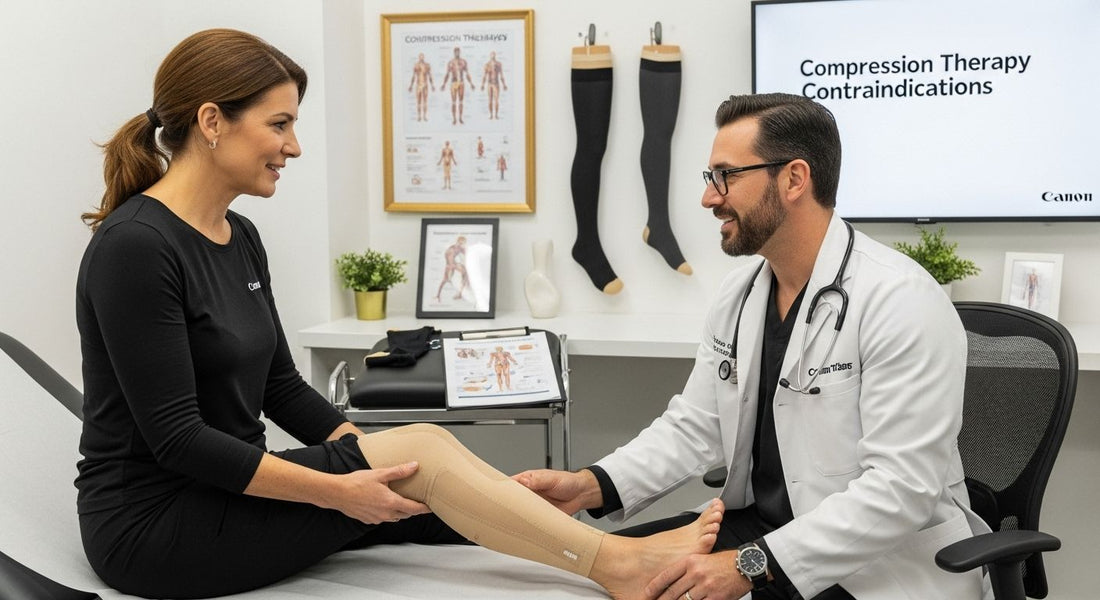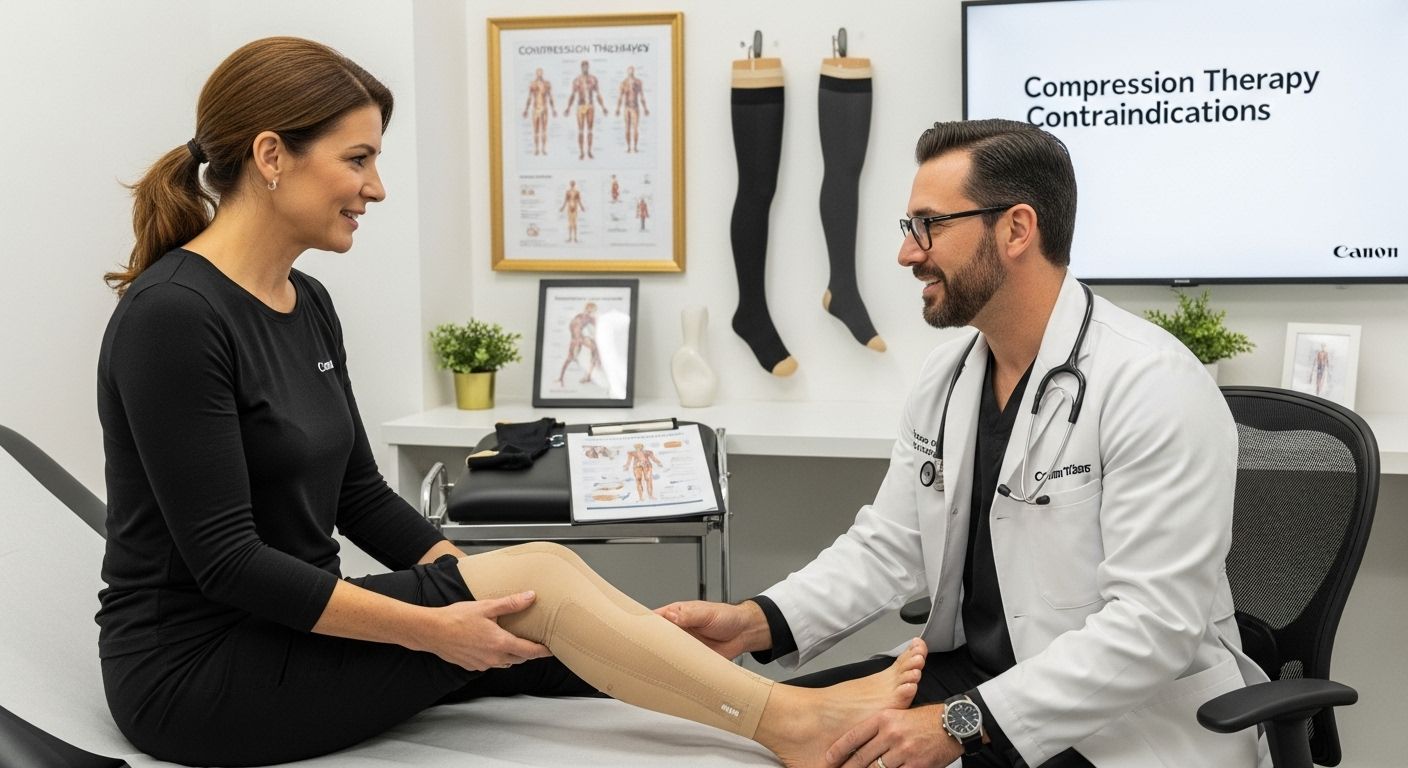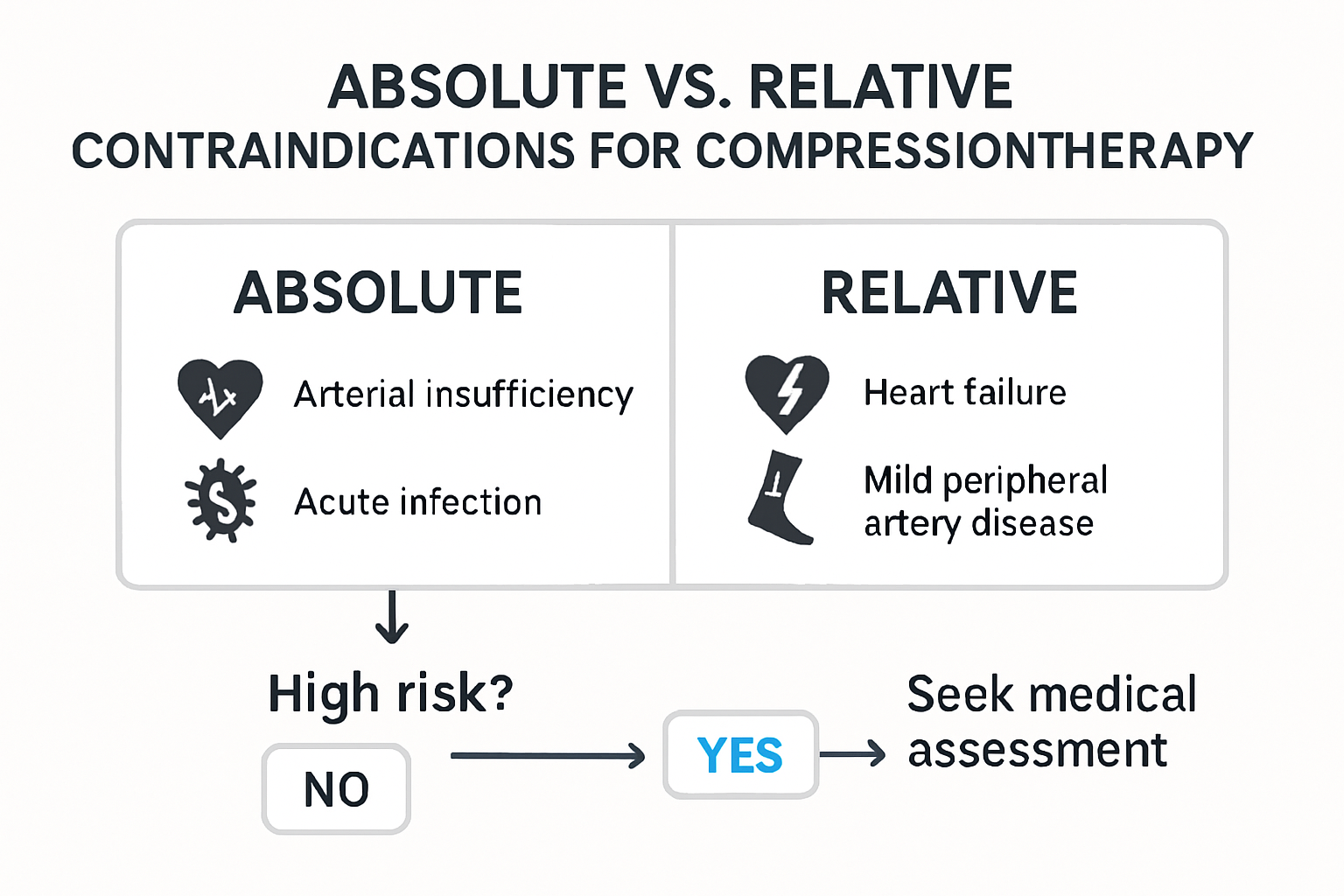
Understanding Compression Therapy Contraindications
Share
Compression therapy can work wonders for circulation, often easing pain and swelling for millions of people with leg issues. That sounds like a safe bet for anyone seeking relief, right? Not so fast. Researchers found that applying compression therapy in the wrong cases, like when the ankle-brachial index falls below 0.5, can cause serious harm and even permanent damage. The real surprise is that people with certain heart or vascular issues are actually at greater risk with compression than without it.

Table of Contents
- What Are Compression Therapy Contraindications?
- Why Knowing Contraindications Is Important for Patients
- How Do Compression Therapy Contraindications Work?
- Key Conditions That May Exclude Compression Therapy
- Understanding the Risks of Ignoring Contraindications
Quick Summary
| Takeaway | Explanation |
|---|---|
| Consult healthcare before compression therapy | Always consult a healthcare professional to evaluate if compression therapy is safe based on individual medical history. |
| Know your contraindications | Being aware of specific health conditions that contraindicate compression therapy can help prevent severe complications. |
| Risk assessment is essential | Comprehensive medical assessments are crucial to determine appropriate use of compression therapy and avoid life-threatening risks. |
| Understand absolute vs relative contraindications | Recognizing the difference can inform treatment decisions and ensure safer therapeutic interventions for patients. |
| Ignoring contraindications can be dangerous | Neglecting essential contraindications may lead to irreversible health damage or serious complications requiring urgent medical attention. |
What are Compression Therapy Contraindications?
Compression therapy is a widely used medical treatment designed to improve blood circulation and reduce swelling in the legs. However, not all patients are suitable candidates for this intervention. Compression therapy contraindications are specific medical conditions or situations where applying external pressure could potentially harm the patient rather than provide therapeutic benefits.
Understanding Medical Limitations
Compression therapy works by applying graduated pressure to help blood flow more efficiently through the veins. Learn more about how compression works in our comprehensive guide. However, certain medical conditions create significant risks that make compression therapy inappropriate or dangerous.
According to research from the National Center for Biotechnology Information, key contraindications include:
- Severe peripheral arterial disease (ankle-brachial index less than 0.5)
- Untreated septic phlebitis
- Acute deep vein thrombosis
- Uncompensated heart failure
Potential Risks of Inappropriate Compression
When compression therapy is applied to patients with these conditions, it can potentially:
- Worsen existing circulatory problems
- Reduce blood flow to already compromised areas
- Increase risk of tissue damage
- Exacerbate cardiovascular complications
Patients must consult healthcare professionals who can comprehensively assess individual medical histories and determine whether compression therapy is safe and appropriate for their specific health situation. Each patient’s unique physiological condition requires personalized medical evaluation to prevent potential complications.
Why Knowing Contraindications is Important for Patients
Understanding compression therapy contraindications is not just a medical formality but a critical component of patient safety and effective healthcare management. Patients who are unaware of potential risks associated with compression therapy might inadvertently expose themselves to serious health complications.
Personal Health Protection
Discover how compression therapy impacts individual health and understand why personalized medical advice matters. According to research published in the National Institutes of Health, identifying contraindications is essential to prevent potential adverse effects that could significantly impact patient well-being.
Knowing contraindications helps patients:
- Prevent unnecessary medical risks
- Understand their unique physiological limitations
- Make informed healthcare decisions
- Communicate effectively with medical professionals
Comprehensive Risk Management
Compression therapy contraindications are not universal but highly individualized. Some patients might have underlying conditions that make external pressure potentially dangerous. Medical professionals must conduct thorough assessments to determine whether compression therapy is appropriate.
Risks of neglecting contraindication screening include:
- Potential circulation disruption
- Increased likelihood of tissue damage
- Potential cardiovascular complications
- Worsening of existing medical conditions
Patients play a crucial role in their healthcare journey. By understanding potential risks, asking informed questions, and working closely with healthcare providers, individuals can ensure safer and more effective treatment strategies. Always prioritize professional medical guidance and comprehensive health evaluations before starting any therapeutic intervention.
How do Compression Therapy Contraindications Work?
Compression therapy contraindications operate through a complex medical assessment process that evaluates potential risks and patient-specific health conditions. The mechanism involves carefully analyzing physiological factors that might make external pressure potentially harmful or counterproductive to a patient’s health.
Physiological Risk Assessment
Explore the fundamentals of compression therapy and understand the intricate evaluation process. According to research from international medical consensus statements, contraindications are no longer considered absolute binary conditions but exist on a nuanced spectrum of potential risks.
Key physiological factors evaluated during contraindication screening include:
- Ankle-brachial pressure index (ABPI)
- Systolic ankle pressure measurements
- Toe pressure levels
- Overall circulatory system functionality
Relative vs Absolute Contraindications
Medical professionals distinguish between two primary categories of contraindications:
- Absolute Contraindications: Conditions that definitively prohibit compression therapy
- Relative Contraindications: Situations requiring careful assessment and potentially modified treatment approaches
For instance, peripheral arterial occlusive disease (PAOD) represents a critical area of concern. Systolic ankle pressure below 60 mmHg or toe pressure less than 30 mmHg signals significant risks that demand comprehensive medical evaluation before considering compression therapy.
The assessment process involves a detailed, personalized approach where healthcare providers meticulously examine individual patient characteristics, existing medical conditions, and potential physiological responses to external pressure. This nuanced evaluation ensures that compression therapy recommendations are tailored to each patient’s unique health profile, minimizing potential complications and maximizing therapeutic benefits.

Key Conditions That May Exclude Compression Therapy
Compression therapy is not a universal treatment, and certain medical conditions can significantly limit or completely prohibit its application. Understanding these conditions is crucial for patient safety and effective medical management.
Cardiovascular and Circulatory Limitations
Learn about safe compression therapy practices and the critical medical considerations. According to research published in the International Wound Journal, several key conditions can exclude patients from compression therapy.
Cardiovascular conditions that may prevent compression therapy include:
- Severe peripheral arterial disease
- Uncompensated congestive heart failure
- Untreated deep vein thrombosis
- Significant arterial insufficiency
Advanced Systemic Health Challenges
Beyond cardiovascular concerns, other health conditions can complicate compression therapy:
- Diabetes with advanced microvascular complications
- Active limb infections
- Acute cellulitis without appropriate antibiotic treatment
- Known allergic reactions to compression materials
- Severe skin disorders or open wounds in the treatment area
Additionally, patients with compromised skin integrity or those experiencing significant sensory impairments require extra caution. Medical professionals must conduct comprehensive assessments to determine whether the potential benefits of compression therapy outweigh the risks for each individual patient. The goal is always to protect patient health while providing the most effective treatment possible.

Understanding the Risks of Ignoring Contraindications
Ignoring compression therapy contraindications is not a minor oversight but a potentially life-threatening medical error. Patients and healthcare providers must recognize that bypassing essential screening processes can lead to severe health complications that far outweigh any potential therapeutic benefits.
Immediate Physical Consequences
Explore safe compression therapy guidelines and understand critical risk factors. According to research from the Journal of Vascular Surgery, disregarding medical contraindications can result in significant physiological damage.
Immediate risks of improperly applied compression therapy include:
- Skin tissue necrosis
- Nerve damage
- Accelerated circulatory deterioration
- Permanent vascular injury
Long-Term Health Implications
Beyond immediate physical risks, ignoring contraindications can trigger chronic health complications:
- Permanent reduction in limb functionality
- Increased cardiovascular stress
- Potential development of secondary medical conditions
- Irreversible damage to peripheral nervous system
- Compromised healing mechanisms
Critical medical conditions like advanced peripheral arterial disease, uncontrolled heart failure, and severe diabetic neuropathy demand exceptional caution. The potential consequences of neglecting professional medical guidance extend far beyond temporary discomfort, potentially resulting in permanent disability or life-threatening medical emergencies. Healthcare professionals must conduct thorough assessments, and patients must transparently communicate their complete medical history to ensure safe and effective treatment strategies.
Safe Compression Starts with the Right Guidance
After learning about compression therapy contraindications, you might worry about whether compression stockings are right for you. We understand that safety is your top priority. The article highlights how essential it is to have the correct medical assessment before starting any compression therapy, especially if you face challenges like varicose veins, lymphedema, diabetes-related circulation problems, or pregnancy-related swelling. Finding the tools to support your health without risking further complications can feel overwhelming.
At Fit Stockings, we bridge information and safe solutions. Our store offers a wide range of medical-grade compression stockings in a variety of gradients and sizes, curated specifically for conditions discussed in the article. You can browse expert guidance on choosing the best compression level for your needs, or visit our homepage to explore trusted brands like Jobst and learn about measuring for a perfect fit. Ready to take the next step toward comfort and safer circulation support? Visit Fit Stockings now to find the compression solutions designed with your well-being at heart.
Frequently Asked Questions
What are the main contraindications for compression therapy?
Compression therapy is contraindicated in several key conditions, including severe peripheral arterial disease, untreated septic phlebitis, acute deep vein thrombosis, and uncompensated heart failure.
Why is it critical to understand compression therapy contraindications?
Understanding contraindications helps prevent unnecessary health risks, ensures informed healthcare decisions, and allows effective communication with medical professionals.
How does compression therapy work for improving circulation?
Compression therapy applies graduated pressure to the legs, promoting better blood flow through the veins and reducing swelling.
What are the potential risks of ignoring compression therapy contraindications?
Ignoring contraindications can lead to serious complications such as skin tissue necrosis, nerve damage, accelerated circulatory deterioration, and long-term health issues like permanent limb dysfunction.
Recommended
- What Is Compression Therapy? Guide for Vein & Leg Health 2025 – Fit Stockings
- Compression Stockings and Diabetes: What to Know in 2025 – Fit Stockings
- Compression Stockings Fitting Guide 2025: Find the Perfect Fit – Fit Stockings
- Can Compression Socks Be Too Tight? What You Need to Know 2025 – Fit Stockings

